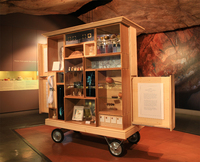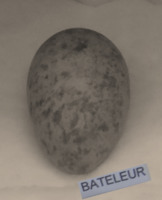Items
Site
The Medicine Chest
keywords is exactly
object ecologies
-

Iroko
Structurally, 'Chest: a botanical ecology' consisted of 15 modular interlocking cabinets of differing sizes which rested on top of one another, making up the front of the display. These were constructed from two types of wood, the darker iroko wood, and a lighter ash wood – with the iroko originating from the repurposed cabinets used for Curiosity CLXXV in 2004. The Iroko tree is a large hardwood tree from the west coast of tropical Africa, known by the Yoruba as ìrókò, logo or loko. Believed to have supernatural properties, it can live up to 500 years. Yoruba people believe that a spirit inhabits the tree, and anybody who sees the Iroko-man face to face becomes insane and dies. According to the Yoruba, any man who cuts down any Iroko tree causes devastating misfortune on himself and all of his family. In West Africa, the iroko wood is also used to make the djembe drum. If they however, need to cut down the tree, they can make a prayer afterwards to protect themselves. Used for a variety of purposes including boat-building, domestic flooring, furniture and outdoor gates, from the late 1990s, it was also used as part of the txalaparta, a Basque musical instrument constructed of wooden boards, due to its lively sound and classified as an idiophone (a percussion instrument) (Ogumfe 1929: online)). -

Notebooks 2 – Nest Records
"'Notebook 2 – Nest Records' is part of the Peter Steyn Collection at the Percy Fitzpatrick Institute of African Ornithology (PFIAO) at the University of Cape Town. It resides in the top drawer of a wooden cabinet that is locked and stained with nepheline. The drawer is shared with two other notebooks created by Steyn, the first from his youth, and the latter is focused on birds of prey. It lies beside a copy of Frank B. Smithe’s Naturalist’s Color Guide, a published article by Steyn, two printed documents, attached letters and an envelope of reference photographs. The subsequent drawers are filled with an array of labelled, blown, eggs. Pink. Blue. Burnt-copper. Speckled. Splattered" (Viruly 2019). -

Prrrip-Prrrip, Tseeeep!: the silence of birds’ eggs
"Birds are highly vocal creatures, their songs sound everyday in almost every habitat, even our concrete cities. These calls have been likened to the human capacity for speech, yet the faculty of language has, for most of history, been described as solely ‘human.’ Language forms one of several traits deployed to uphold the constructed divide between human and non-human animals. Oology – the collecting and documenting of wild bird eggs – was an obscure hobby and ‘science’ of the past. Collected eggs were pierced and ‘blown’ of their contents. The perfect shells, beautifully coloured with speckles and intricate patterns, were then placed in vast cabinet collections. Such a birds’ egg collection, collected in Southern Africa during the last half of the 20th century, forms the starting point of this exhibition. Through exploring language and communication in birds, this exhibition aims to create an affective environment for re-evaluating the collecting practices of the past (with its ties to the Euro-Western, human-centered perspective), and for re-imagining current natural history collections. It also aims to … poo-too-eee poo-too-eee, pa-chip-chip-chip per chick-a-ree. Ka-ha, ka-ha, kuh-uk-uk-uk! caw-caw-caw-caw-koodle-yah, loooooo-eee! Pa-chip-chip-chip, per-chick-a-ree!" Wall text of exhibition, Prrrip-Prrrip, Tseeeep!: the silence of birds’ eggs -

Bataleur egg
Situated in a locked bespoke cabinet in the Niven Library in UCT’s Percy Fitzgerald Institute of African Ornithology, this Bataleur eagle egg is part of a collection of eggs donated by the ornithologist Peter Steyn in 2007. Collected between 1961 and 1977, when Steyn spent time in Zimbabwe, the egg is a link to the iconic stone carved Zimbabwe Birds which once stood proudly on guard atop the walls and monoliths of the ancient city of Great Zimbabwe, believed to be built between the 12th and 15th centuries by ancestors of the Shona. The overall shape of the birds suggests that of a bateleur eagle – a bird of great significance in Shona culture. The bateleur or chapungu is a good omen, the symbol of a protective spirit and a messenger of the gods.


